London Newcastle Space
28 Redchurch St
Shoreditch, London
5 – 26th Feb 2015
All photos: NoLionsInEngland
Spanish street artist Borondo moved to London in early 2014 and blew us away with his street art. It was painterly, impressionist and frankly very inventive.

Shoreditch, 2014
Had we ever seen a piece of street art specifically designed to be viewed as a reflection? No, so Borondo does it.
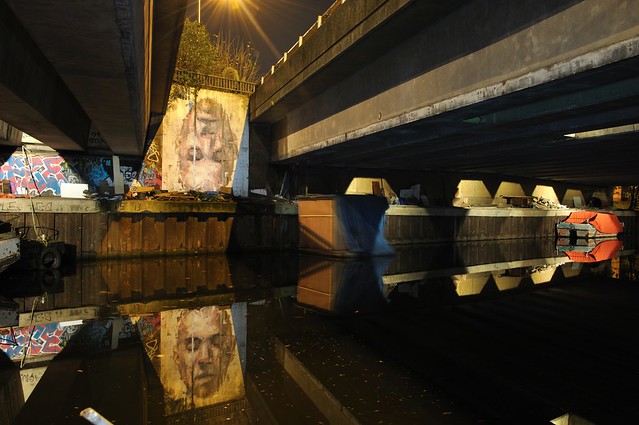
Hackney Wick, 2014
His long awaited debut London solo show is an epic exploration of light, space, time and behaviour; Borondo checks out mankind’s role as the beast-king, the top of the food chain.
Borondo’s conversion of the space yields a series of zones which we journey through. The first, “Prologos” introduces a manifesto regarding man’s fear of and thus desire to conquer nature, set against a trio of flickering super-8 cine projections and a floor of bark chippings. Anyone who has ever taken their kids to a playground and witnessed the juvenile puking, peeing and nappy disgorging that takes place on bark chippings is going to hasten through this earthy terrain.
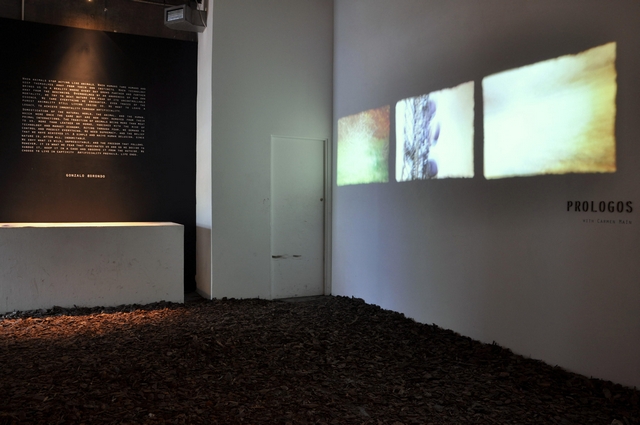
"Prologos". Borondo/Carmen Main
Last year in conversation, Borondo confided that before he had a show here he really wanted to understand what made London tick, he wanted London to get under the skin of the art and this gives us a very interesting lens to view this work through. We progress through a corridor of mounted antlered skulls which bring to mind the stately symbols of authority, power, "sporting" triumph and wealth we see in the homes of British gentry. Hunt trophies, how English, how human. This is one of three zones created as collaborations with other artists and craftsmen, in this case Despina Charitonidi, to some extent we are left wondering how much beyond the concept was Borondo responsible for the creation of this element.
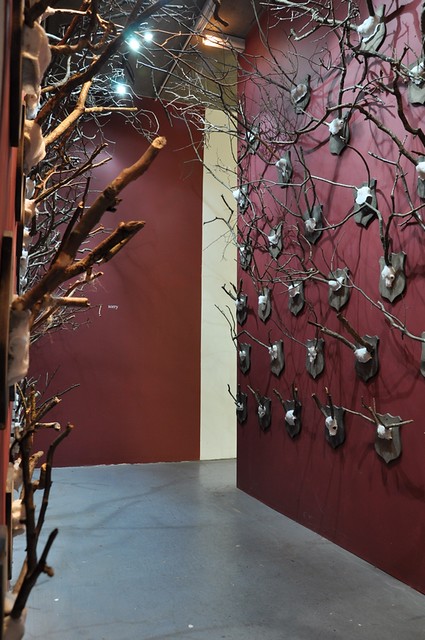
"The Passage". Borondo/Despina Charitonidi
In the next zone, the highlight of the show, are sash windows with ghostly figures etched into whitewash on the glass and illuminated by a series of projectors. On the rear of each window there is painted evidence of man’s supremacy as hunter, We see furs, stoles, dead creatures and the pair of images on the front and reverse of each window combine beautifully in the silhouette cast on the wall by the light from the projectors. The projectors clunk and whir as the slide change mechanism operates (there aren’t actually any slides in the carousels) and if you listen carefully, the sound is processed and amplified ever so slightly to give it a deathly resonance and reverberation. Below each window a pile of scrap wood and chippings may suggest collateral damage fallout from the battle between man and beast.
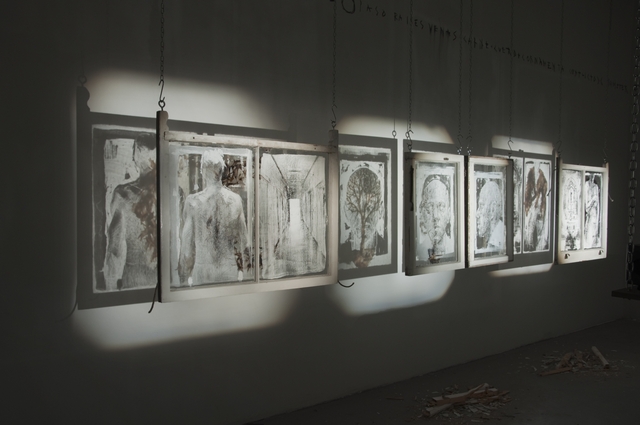
"Entranas"
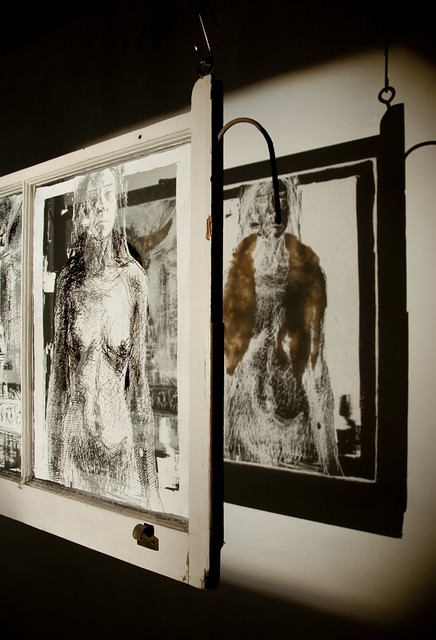
"Entranas"
Borondo has painted bales of hay in fields which not an easy feat and he brings this shadowy technique into this show with a mother protecting a gathering of children. Generally there is a separation of the roles of women and men in this show, we see women as prey, as protector and, adorned with the furs and spoils from the hunt in the room of sash windows, as decorated trophy.
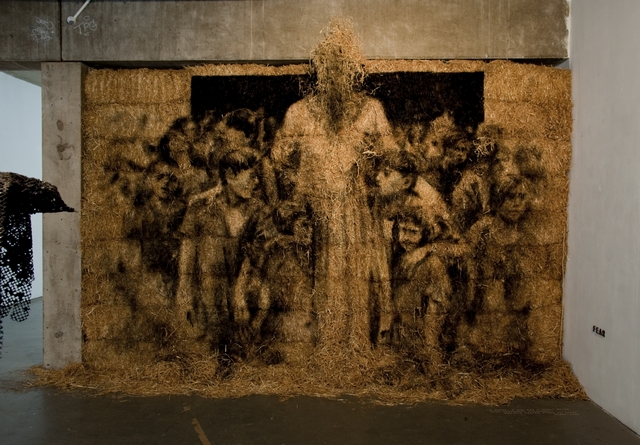
"FEAR"
One of the most intriguing zones, sharing a space with the hay bales is a trio of fine mesh cubes from which birds are escaping. Inside the cages the birds are flimsy, pale and lifeless, as they emerge through the cage and out into freedom they become strong and full bodied. The metaphor contrasting slavery and freedom is obvious but also the birds remind us of ravens, again this is a London thing, we have a pointless kind of myth about the crown falling if the ravens ever leave the Tower Of London. If only revolution were that easy. The metaphor can also remind us that captivity isn’t just about creatures in cages, many of us can’t survive without contracts, more or less willingly we enter into contracts which have a similar effect in limiting our freedom, think employment, I bet some of you are also adding "marriage" to the list.
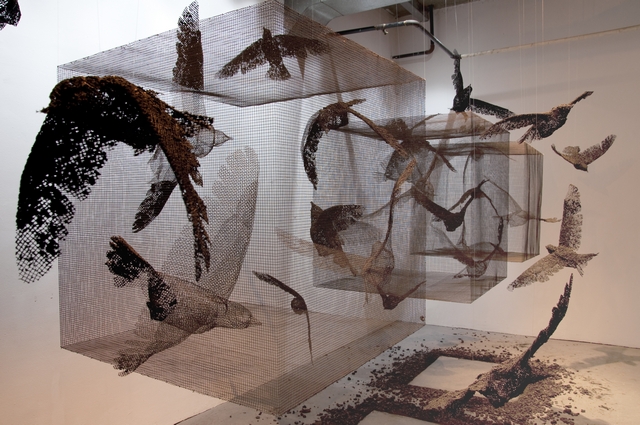
"CONTROL". Borondo/Edoardo Tresoldi
Another small enclosed space appears to be a cage with the protective glass smeared and dirty as if a captured animal has been trying to escape. The guide notes for the show talk about the presence of a pregnant women, a pun on the double meaning of the word "confined" but to these eyes it looks like one of those irritating zoo compounds where the precious wild life has had a moody and gone to hide backstage in its sleeping quarters (I can't see the link pregnant woman link).
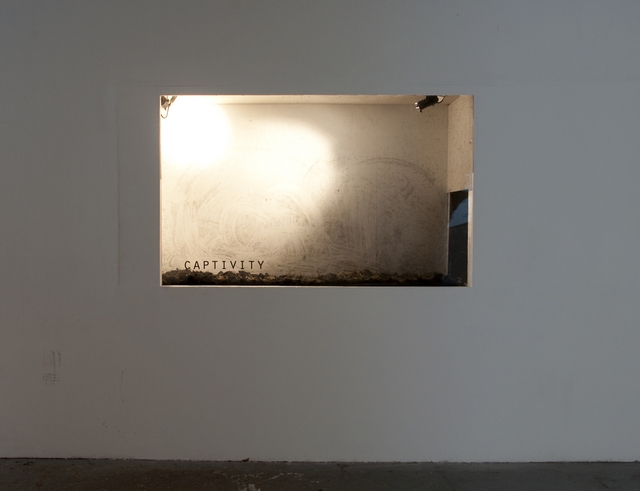
"CAPTIVITY"
An animation in the next space has a naked women prowling in circles while a tom tom percussion sounds out the beat of a march to war. Friday nights down the disco were always thus. It seems that’s not quite how Borondo sees it, curiously the guide text makes it appear that the women is somewhat to blame, craving her own routine, domesticity and capture. Parading like this would do the trick.
"LA CARNE". Borondo/Carmen Main
A collection of paintings reflecting details of poses from the animation painted on canvas is arranged like a haunting stained glass window. In the animation you can actually brief moments when those canvasses are placed onto the wall to be painted in the process of making the film.

"LA CARNE". Borondo/Carmen Main
Then we come to a small enclosed dead end in which Borondo manages a fascinating play with time which eluded me the first time I visited the show. A short narrow passage lined floor and ceiling with real grass on one side and artificial astro turf on the other guides our sight towards a wreath at the far end. In the early days immediately after opening this was a luminous green space bursting with life and colour with the wreath perhaps reminding us of our ephemerality or destiny. Returning after two weeks the process of decay and discolouration has withered the “real” half of the room while the fake artificial elements opposite survive unchanged by the passage of time. Even the wreath is half and half real and fake, the half of the wreath made of real flowers has decayed, petals have dropped off, stems have wilted while the fake half, placed over the real dying greenery of the natural grass radiates an un-natural healthiness.

"ETERNAL"
In another compartment a lantern of framed portraits scratched into white paint on glass hangs mute in a sparsely illuminated room. A message on the glass confirms that this is THE END. The paintings are as ghostly as any of the larger windows Borondo has painted on the streets of London and the play of shadow and light on the floor and into the lighthouse lantern of the sculpture is as significant as the portraits themselves.

"ALBEARE"
One more corridor hung with framed rough impressionist skulls numbered 1 to 6 show how man’s bestiality is not just a mind set, as the numbers increase the jaws of the skulls protrude more and more, becoming more sabre toothed and beast like in the progression.
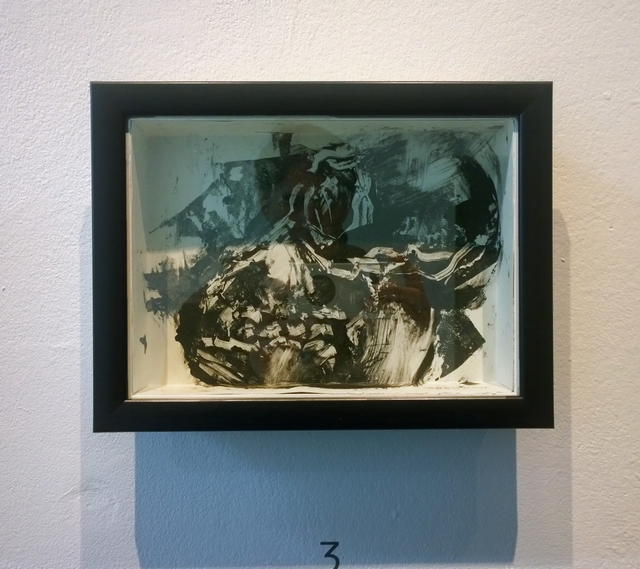
Finally, perhaps the piece de reistance, a collection of canvasses adorn the walls of a large cube space like trophies while in the centre of the room hang three hunt scenes painted on Perspex. In each of the scenes, man the victor poses with the ruined remains of his once beautiful and majestic prey. Painting on Perspex is a cunning device. Simultaneously Bronodo allows us to see the progression of the hunt scene, we are at the posing-for-souvenirs stage and he has chosen to allow us views through the perspex to the similar scenes of triumphalism hanging behind while from the rear he shows us the very rough background to the scenes, the crude impressionist strokes making up the base layer of each scene. Borondo wants us to see how base we are behaving like this.
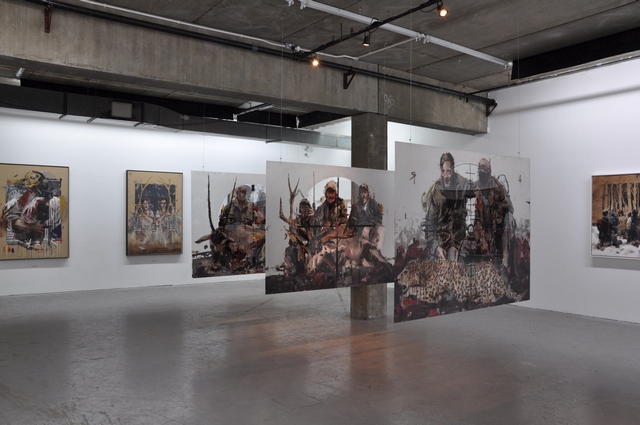
"EPILOGOS"
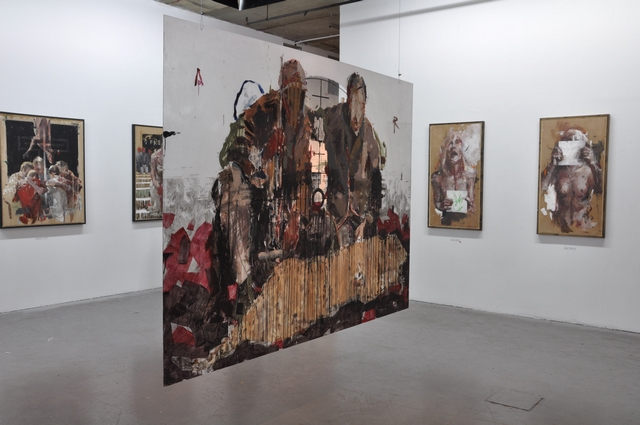
"EPILOGOS"
Is this work art? Too damn right. A huge amount of care and thought has gone into every detail of every piece of art and each room and the overall progression and concept. This is hugely deserving of proper critique and coverage by the educated and intellectual critics who share their plum-voiced opinions in “proper” magazines and newspapers. At the same time, it speaks to anyone and everyone, there is no need to acquaint oneself with bizarre intellectual concepts to see and enjoy what Borondo's art is about, we can all see this is beautiful painting and the symbolisms are straight forward, in fact, pretty much that all that street art stands for, we can all “get it”.
Beastiality, it’s innate innit.
More photos here

Excellent synopsis
ReplyDelete